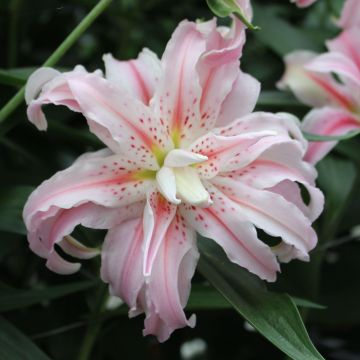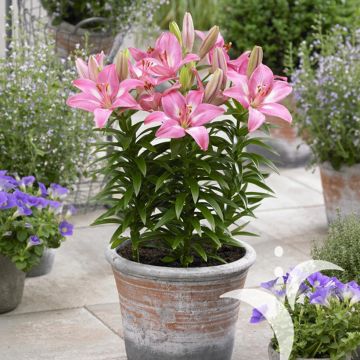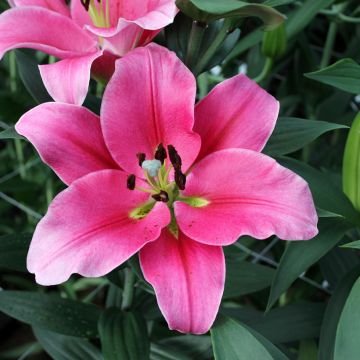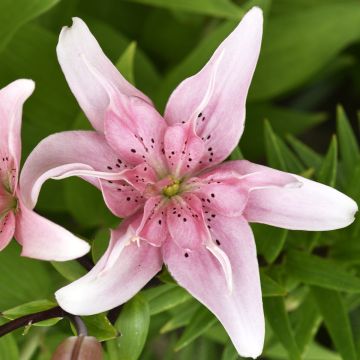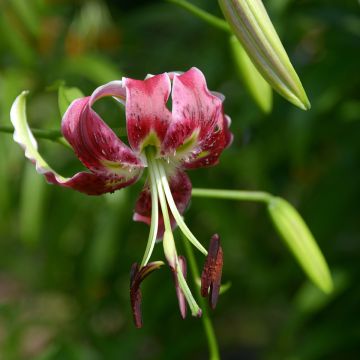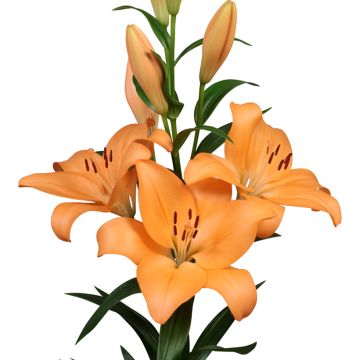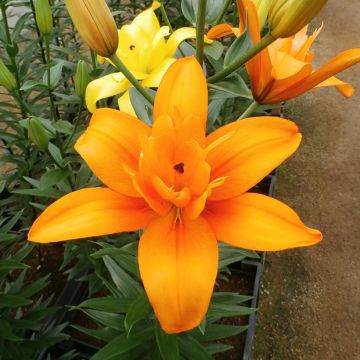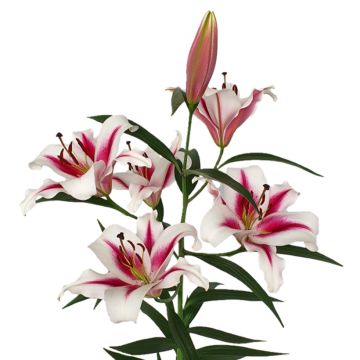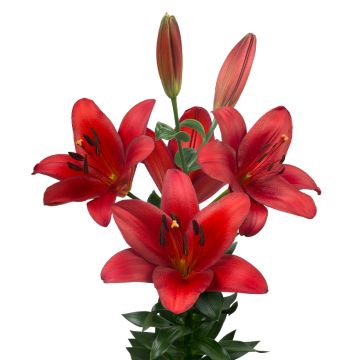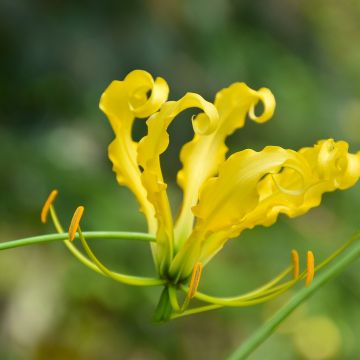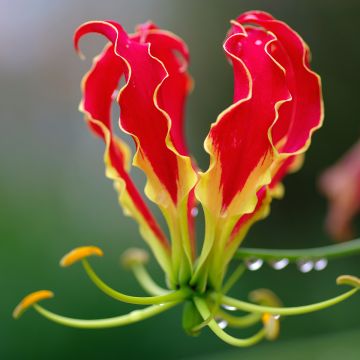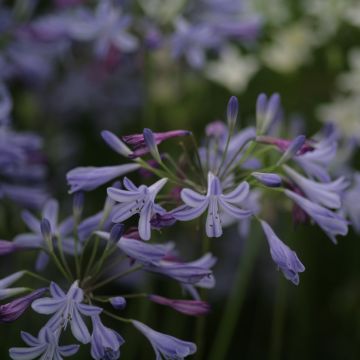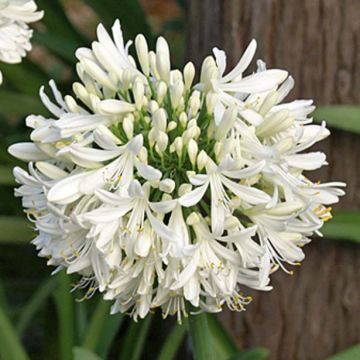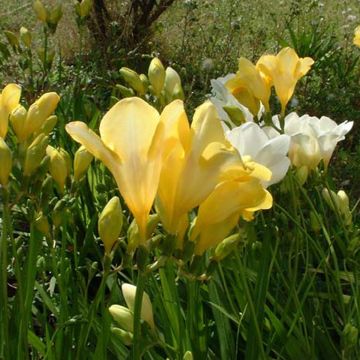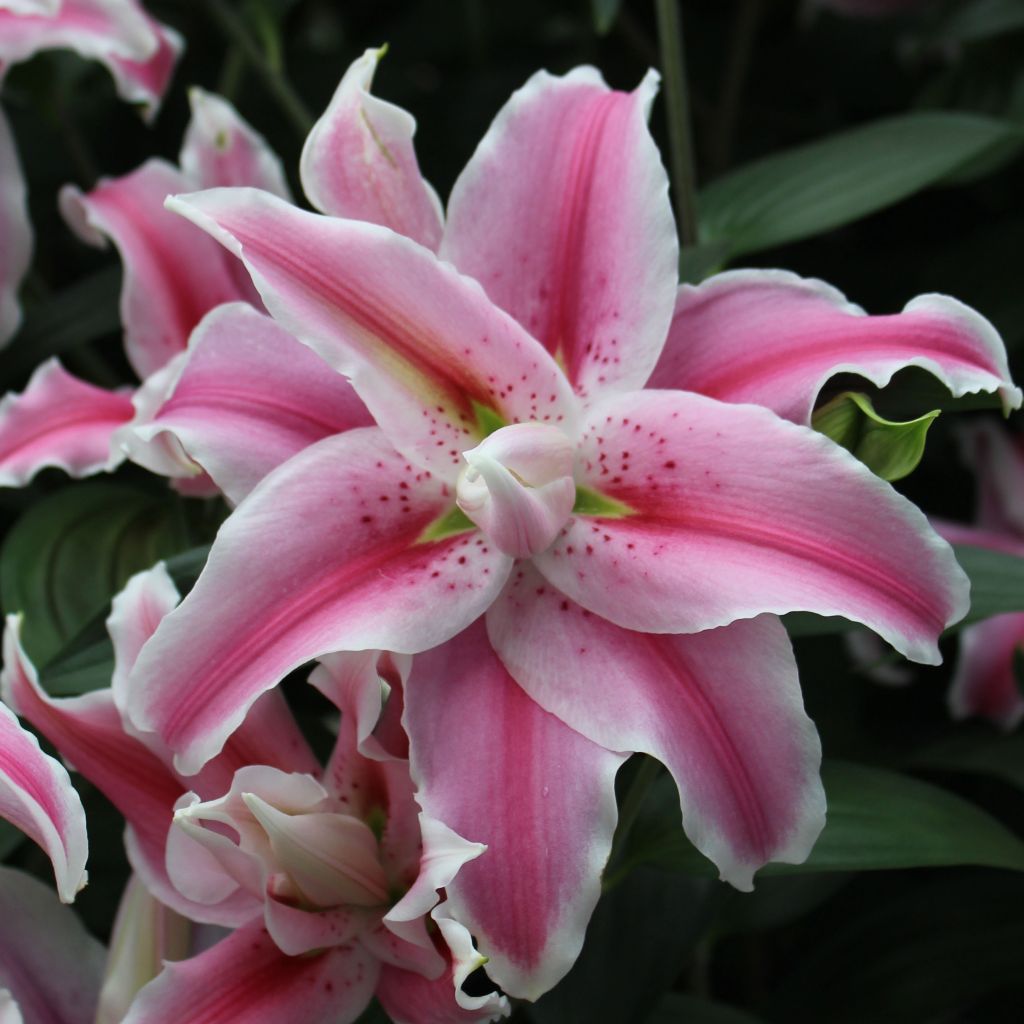

Lilium Distant Drum
Lilium Distant Drum
Lilium Distant Drum
Lily
I planted them in large pots. The bulbs don't all grow every year, but almost! I never tire of it :-)
Florence, 11/08/2017
Why not try an alternative variety in stock?
View all →This plant carries a 6 months recovery warranty
More information
We guarantee the quality of our plants for a full growing cycle, and will replace at our expense any plant that fails to recover under normal climatic and planting conditions.
From €5.90 for pickup delivery and €6.90 for home delivery
Express home delivery from €8.90.

Does this plant fit my garden?
Set up your Plantfit profile →
Description
The double asian lily 'Distant Drum' is as captivating for the beauty of its flowers as it is for its sweet fragrance. This recent variety produces double flowers in summer, with a perfect texture. The colour is a deep pink nuanced with pale pink, barely marked by small yellow signals at the throat. Its very sturdy stems bear up to 6 flowers grouped in umbels. It is a robust and easy-to-grow plant, reliably flowering every year. It will bring a lot of charm and freshness to borders or large rockeries. It is obviously a wonderful cut flower.
The 'Distant Drum' lily is a deciduous bulbous plant, with a narrow and very upright habit from spring onwards. It belongs to the lily family. This plant will reach 70 to 90 cm (28 to 35in) in height, increasing in strength over the years, and the clump will spread without a theoretical limit over time, with the bulbs producing bulblets through vegetative multiplication. The spectacular flowering takes place in July-August. Along the particularly strong stems, up to 6 wide, fragrant flowers, grouped in umbels, appear upright. They are fleshy and waxy, deep pink, edged with pale pink in the centre of the petals. At full bloom, small pale yellow areas can be seen near the throat. The reverse side of the floral pieces is tinged with light yellow-green. The peculiarity of its flowers lies in their duplication; 3 ranks of outer petals, much larger, arranged in a staggered manner, surround a small central corolla formed by 3 light pink petals. The stamens of double-flowered hybrids do not produce pollen. The stems are covered with alternate, medium green, narrow and shiny leaves.
A plant that prefers rich humus soil, this lily appreciates well-drained and light soils. It can be associated with perennial plants or modest and sparse bushes such as dwarf maples or deciduous azaleas, as it likes to have its base in the shade. The latter will help prevent the stems from bending under the effect of the wind. 'Distant Drum' pairs well with daylilies, chamomiles, and Coreopsis, as well as roses. The lily is ideal for borders and, of course, for bouquets.
Report an error about the product description
Lilium Distant Drum in pictures
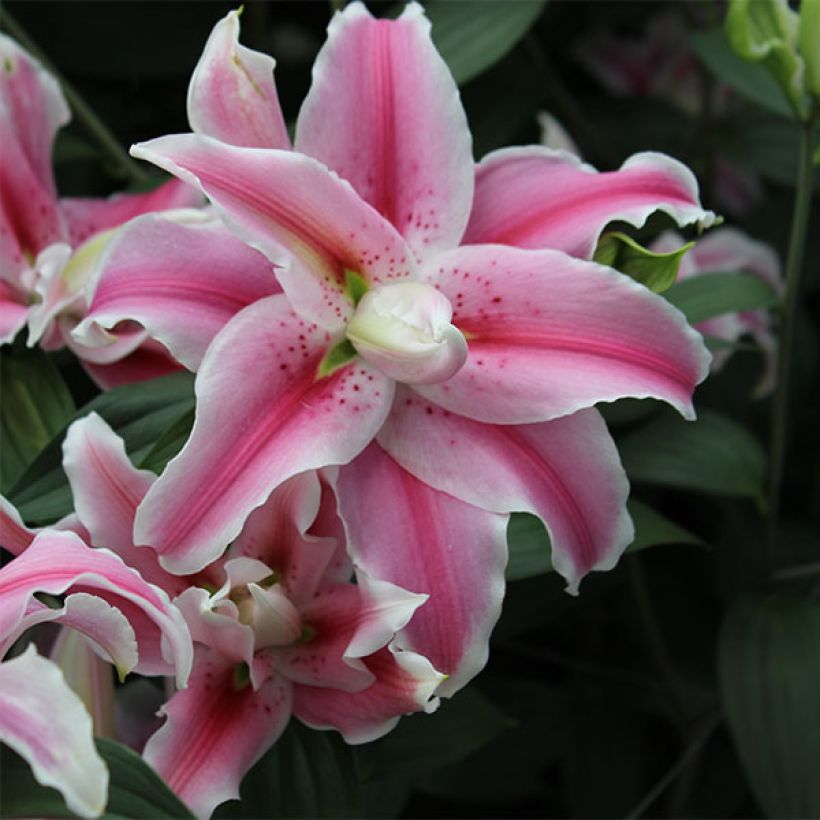

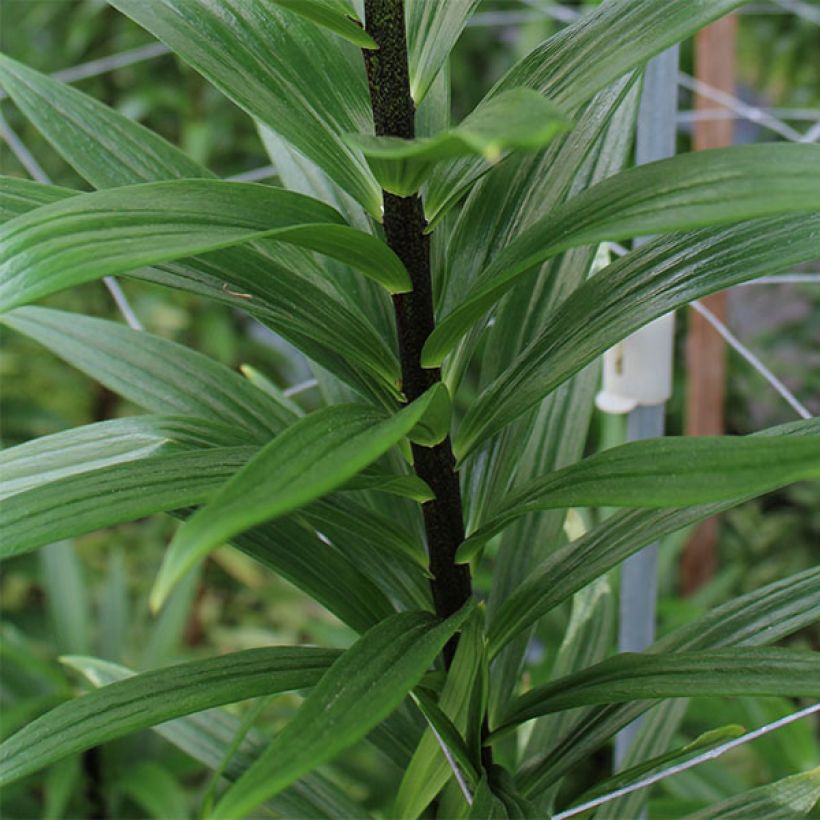

Plant habit
Flowering
Foliage
Botanical data
Lilium
Distant Drum
Liliaceae
Lily
Cultivar or hybrid
Other Hybrid Lilies
Planting and care
The 'Distant Drum' lily appreciates humus-rich, fertile, well-drained, and light soils. You will plant it in full sun, preferably in spring, burying the bulbs 15 cm (6in) deep in soil mixed with leaf compost. In a pocket of sand, they will avoid rotting as well as attacks from slugs. Mark the planting location, as vegetation only starts in April.
When the stems reach 30 cm (12in) in height, discreetly stake them. If red insects appear, treat them without delay, as they are red lily beetles whose larvae can devour all the leaves. The most effective method is to catch them manually, but be careful as they drop as soon as you touch them, so put a box underneath. Otherwise, treat regularly with permethrin. After flowering, it is useful to cut the faded flowers halfway to keep the bed beautiful during the summer.
Tips for planting lilies in compact soil: Bulbous bulbs of large lilies fear clay soils that suffocate them and cause rotting. In Eastern Europe, they are planted on 'benches' built above ground level. These benches are made up of a first layer of gravel, on which tightly packed branches are placed. Then cover everything with a thick layer of compost, 20 to 30 cm (8 to 12in) deep. Plant the bulbs in the compost, on which a few ground-cover plants can also crawl.
On the terrace, you can create sumptuous pots with lilies. Choose a container that is large and deep enough (at least 16 cm (6in) for one bulb). Fill it with a mixture of garden soil, leaf compost, and sand. Plant the lilies in groups of 3 to 5 bulbs, depending on the size of the pot, at a distance of 10-15 cm (4-6in), then water abundantly. Place the pots in a cool room or outside once the frost has passed. Apply liquid fertiliser twice a month until the flower buds appear.
Planting period
Intended location
Care
-
, onOrder confirmed
Reply from on Promesse de fleurs
Bulbs to grow in pots
Haven't found what you were looking for?
Hardiness is the lowest winter temperature a plant can endure without suffering serious damage or even dying. However, hardiness is affected by location (a sheltered area, such as a patio), protection (winter cover) and soil type (hardiness is improved by well-drained soil).

Photo Sharing Terms & Conditions
In order to encourage gardeners to interact and share their experiences, Promesse de fleurs offers various media enabling content to be uploaded onto its Site - in particular via the ‘Photo sharing’ module.
The User agrees to refrain from:
- Posting any content that is illegal, prejudicial, insulting, racist, inciteful to hatred, revisionist, contrary to public decency, that infringes on privacy or on the privacy rights of third parties, in particular the publicity rights of persons and goods, intellectual property rights, or the right to privacy.
- Submitting content on behalf of a third party;
- Impersonate the identity of a third party and/or publish any personal information about a third party;
In general, the User undertakes to refrain from any unethical behaviour.
All Content (in particular text, comments, files, images, photos, videos, creative works, etc.), which may be subject to property or intellectual property rights, image or other private rights, shall remain the property of the User, subject to the limited rights granted by the terms of the licence granted by Promesse de fleurs as stated below. Users are at liberty to publish or not to publish such Content on the Site, notably via the ‘Photo Sharing’ facility, and accept that this Content shall be made public and freely accessible, notably on the Internet.
Users further acknowledge, undertake to have ,and guarantee that they hold all necessary rights and permissions to publish such material on the Site, in particular with regard to the legislation in force pertaining to any privacy, property, intellectual property, image, or contractual rights, or rights of any other nature. By publishing such Content on the Site, Users acknowledge accepting full liability as publishers of the Content within the meaning of the law, and grant Promesse de fleurs, free of charge, an inclusive, worldwide licence for the said Content for the entire duration of its publication, including all reproduction, representation, up/downloading, displaying, performing, transmission, and storage rights.
Users also grant permission for their name to be linked to the Content and accept that this link may not always be made available.
By engaging in posting material, Users consent to their Content becoming automatically accessible on the Internet, in particular on other sites and/or blogs and/or web pages of the Promesse de fleurs site, including in particular social pages and the Promesse de fleurs catalogue.
Users may secure the removal of entrusted content free of charge by issuing a simple request via our contact form.
The flowering period indicated on our website applies to countries and regions located in USDA zone 8 (France, the United Kingdom, Ireland, the Netherlands, etc.)
It will vary according to where you live:
- In zones 9 to 10 (Italy, Spain, Greece, etc.), flowering will occur about 2 to 4 weeks earlier.
- In zones 6 to 7 (Germany, Poland, Slovenia, and lower mountainous regions), flowering will be delayed by 2 to 3 weeks.
- In zone 5 (Central Europe, Scandinavia), blooming will be delayed by 3 to 5 weeks.
In temperate climates, pruning of spring-flowering shrubs (forsythia, spireas, etc.) should be done just after flowering.
Pruning of summer-flowering shrubs (Indian Lilac, Perovskia, etc.) can be done in winter or spring.
In cold regions as well as with frost-sensitive plants, avoid pruning too early when severe frosts may still occur.
The planting period indicated on our website applies to countries and regions located in USDA zone 8 (France, United Kingdom, Ireland, Netherlands).
It will vary according to where you live:
- In Mediterranean zones (Marseille, Madrid, Milan, etc.), autumn and winter are the best planting periods.
- In continental zones (Strasbourg, Munich, Vienna, etc.), delay planting by 2 to 3 weeks in spring and bring it forward by 2 to 4 weeks in autumn.
- In mountainous regions (the Alps, Pyrenees, Carpathians, etc.), it is best to plant in late spring (May-June) or late summer (August-September).
The harvesting period indicated on our website applies to countries and regions in USDA zone 8 (France, England, Ireland, the Netherlands).
In colder areas (Scandinavia, Poland, Austria...) fruit and vegetable harvests are likely to be delayed by 3-4 weeks.
In warmer areas (Italy, Spain, Greece, etc.), harvesting will probably take place earlier, depending on weather conditions.
The sowing periods indicated on our website apply to countries and regions within USDA Zone 8 (France, UK, Ireland, Netherlands).
In colder areas (Scandinavia, Poland, Austria...), delay any outdoor sowing by 3-4 weeks, or sow under glass.
In warmer climes (Italy, Spain, Greece, etc.), bring outdoor sowing forward by a few weeks.


































